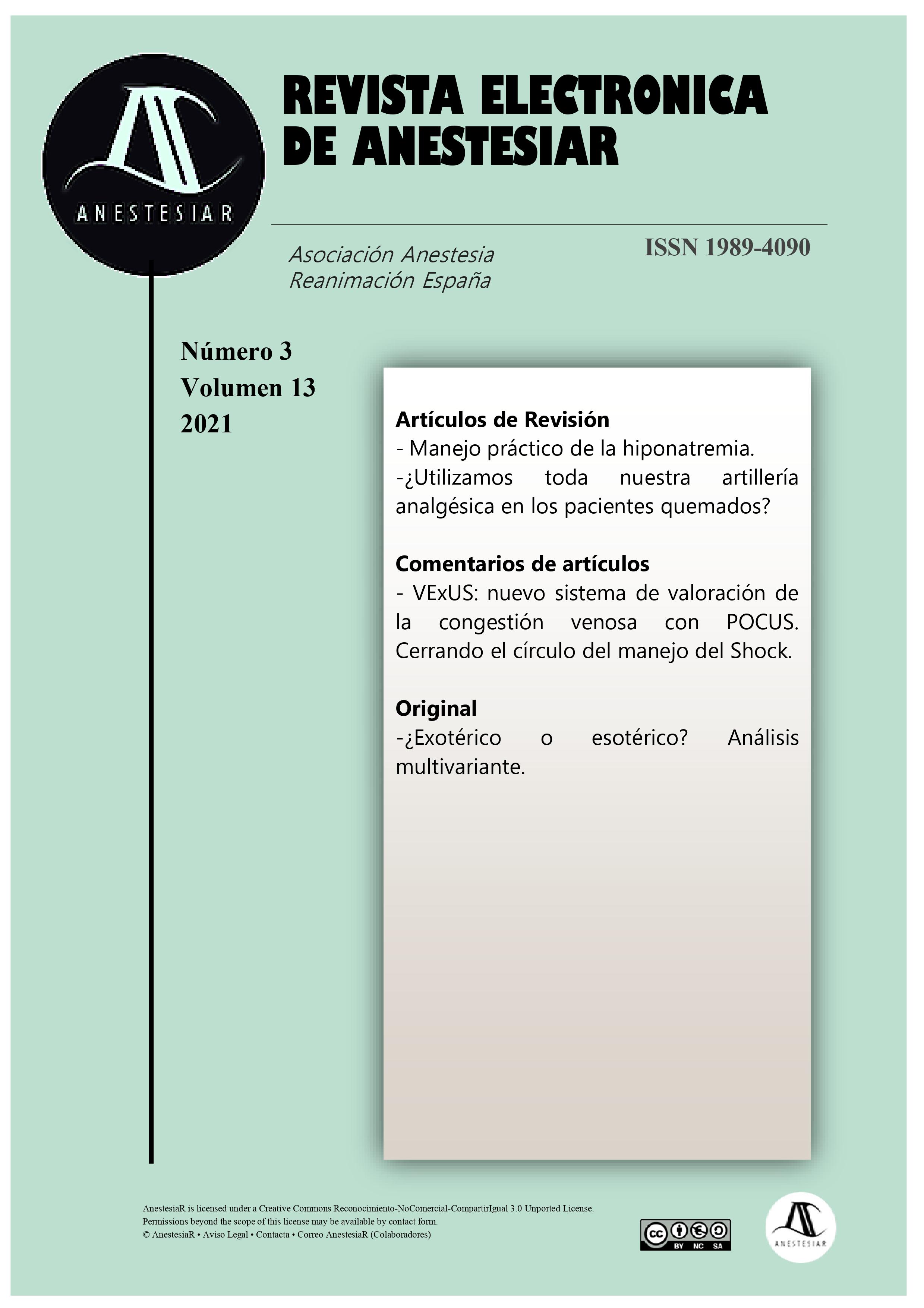Practical management of hyponatremia
DOI:
https://doi.org/10.30445/rear.v13i3.968Keywords:
Hyponatremia, critical, osmolarity, electrolytes, volemiaAbstract
Hyponatremia is the most prevalent electrolyte disorder, so knowledge of its diagnosis and treatment is essential in standard clinical practice. Hypoosmolar hyponatremia is defined as decreased plasma sodium concentration below 135 mEq/L, associated with a decrease in plasma osmolarity. Its speed of development and its symptoms determine the urgency of treatment. Treatment must be individualized and monitored to prevent osmotic demyelination syndrome, the most serious complication of overly rapid correction.
For the writing of this review article, a search has been carried out on the UpToDate and PubMed platforms of the review articles and systematic reviews published over the past five years, in Spanish and English, with the keywords: hyponatremia, critically ill, osmolarity and volemia. Books are indicated in the references section.
References
Broch Porcar MJ, Rodríguez Cubillo B, Domínguez-Roldán JM, Álvarez Rocha L, Ballesteros Sanz MÁ, Cervera Montes M, et al. Documento práctico del manejo de la hiponatremia en pacientes críticos. Med Intensiva. 2019; 43 (5): 302-316.
Jiménez Murillo L, Montero Pérez FJ. Urgencias endocrinometabólicas. Hiponatremia. Medicina de urgencias y emergencias. Guía diagnóstica y protocolos de actuación, 5ª ed. Barcelona: Elsevier; 2015: 488-492.
Suárez Pita D, Vargas Romero JC, Salas Jarque J, Losada Galván I, de Miguel Campo B, Catalán Martín PM, et al. Trastornos del equilibrio hidroelectrolítico. Síndrome de secreción inadecuada de hormona antidiurética. Fluidoterapia. Alteraciones en el equilibrio del sodio y el agua. Manual de Diagnóstico y Terapéutica Médica. Hospital Universitario 12 de Octubre, 8ª ed. Madrid: Jiménez Godoy S.A; 2016: 1127-1132.
Winn Seay N, Lehrich RW, Greenberg A. Diagnosis and Management of Disorders of Body Tonicity—Hyponatremia and Hypernatremia: Core Curriculum 2020. AJKD. 2019; 75 (2): 272-286. doi: 10.1053/j.ajkd.2019.07.014.
Thanippuli Arachchige D, McClure J. Electrolyte disorders in the critically ill. Anaesthesia and intensive care medicine. 2020; 21 (3): 147-153.
Sterns RH, Emmett M, Forman JP. Osmotic demyelination syndrome (ODS) and
overly rapid correction of hiponatremia. UpToDate. Wolters Kluwer; 2020. Disponible en www.uptodate.com.
Sterns RH, Emmett M, Forman JP. Causes of hypotonic hyponatremia in adults. UpToDate. Wolters Kluwer; 2020. Disponible en www.uptodate.com.
Hoorn EJ, Zietse R. Diagnosis and Treatment of Hyponatremia: Compilation of the Guidelines. J Am Soc Nephrol. 2017; 28: 1340–1349. doi: https://doi.org/10.1681/ASN.2016101139.
Adrogué Madias HJ. Primary Care: Hyponatremia. NEJM. 2000; 342 (21): 1581-1589.
Sterns RH. Treatmente of Severe Hyponatremia. Clin J Am Soc Nephrol. 2018; 13: 641–649. doi: https://doi.org/10.2215/CJN.10440917.
Downloads
Published
How to Cite
Issue
Section
License
Copyright (c) 2021 Revista Electrónica AnestesiaR

This work is licensed under a Creative Commons Attribution-ShareAlike 4.0 International License.
 Envío y derechos de autor
Envío y derechos de autor


 Revista Electrónica AnestesiaR by
Revista Electrónica AnestesiaR by 